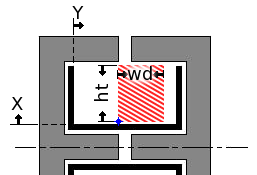 Simulation Mode Simulation Mode
1-D Internal Field Simulation:
The 1-D simulation is less accurate than the 2-D simulation but doesn't require the user to specify the specific winding geometry. The difference can be particularly significant in cases with high magnetizing currents that occur with relatively low-permeability or widely gapped cores.
It assumes a radially- and axially- symmetric magnetic field. One aspect of this symmetry is magnetic field lines that are all parallel to the center axis of the inductor windings.
Inputs:
- current waveform
- core window height and breadth
- gap location
- winding packing factor
- wire size and build
- turn length and number of turns.
2-D Internal Field Simulation with User Specified Winding Cross Section:

The 2-D simulation is more accurate than the 1-D simulation but requires the user to specify the bobbin window dimensions (in addition to the core window). The 2-D simulation can be particularly advantageous versus 1-D in cases with high magnetizing currents that occur with relatively low-permeability or widely gapped cores.
The "user specified winding cross section" mode allows the user to specify the specific geometry of the winding cross section (unless "assume layered windings" is checked), rather than assuming that the windings are simply stacked as in the "2-D, layered" option. dimensions of each winding cross section. It runs a finite element model that takes into account axial and radial components of the magnetic field, and assumes that the field is rotationally symmetric about the center of the winding.
Inputs:
- piecewise linear current waveform for each winding
- core and bobbin window dimensions
- core gap length and location
- winding turns and turn length
- wire gauge, build and packing factor
- cross-section dimensions of the winding (i.e. where the winding is located within the winding window, and its height and breadth).
User-supplied magnetic field data:
This option allows the user to input their own values for the magnetic field analysis, i.e. from an external finite element simulation software. In addition to the piecewise linear current waveform, core and bobbin window dimensions, winding and wire specifications, the user must input the volume of each winding, and the integral of the square of the magnetic field (in T^2) over each winding with 1 amp simulated in it and each of the other windings, as well as 1 amp in different combinations of all of the windings (details will be specified in the following prompts).
Additional instructions are provided on the "Using your own FEM software" page.
|